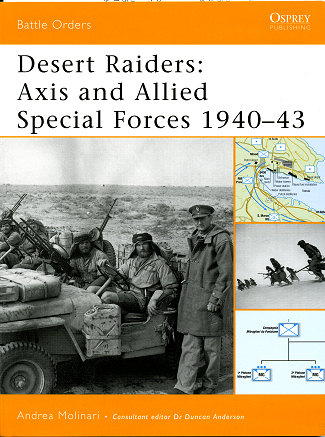 The
war in the North African desert is one that saw a great deal of innovation. As
much due to the strangeness of the environment over what the combattants were
normally used to. Both Germany and the British/Allied forces had planned for a
European war, so there was little in terms of equipment and training to prepare
their armies for desert battle. The Italians, on the other hand, were used to
the environs, as much due to their African colonies as anything. They had
equipment that was suited to desert warfare, but they did not always have the
leadership needed to be successful.
The
war in the North African desert is one that saw a great deal of innovation. As
much due to the strangeness of the environment over what the combattants were
normally used to. Both Germany and the British/Allied forces had planned for a
European war, so there was little in terms of equipment and training to prepare
their armies for desert battle. The Italians, on the other hand, were used to
the environs, as much due to their African colonies as anything. They had
equipment that was suited to desert warfare, but they did not always have the
leadership needed to be successful.
It probably is no surprise that the majority of the book is
dedicated to the British and their Long Range Desert Groups (LRDG). The only
other real player on the Allied side was the Free French who were operating out
of Chad, and while their initial forays against the Italians in southern Libya
were successful, other operations were not and they were soon out of the picture
for most of the North African campaign.
The book mostly covers the development of the LRDG from its
beginnings as a patrol and the lessons learned in operating these groups. It was
soon discovered that they did not have the fire power to overwhelm fixed Italian
positions. Through the usual trial and error as well as a series of unsuccessful
operations, lessons were learned and the LRDG was trimmed down to less than half
its usual size. The missions were then either reconnaissance or delivery and
pick-up of special SAS commando groups. In this way, the LRDG was able to use
its speed and mobility to its best advantages.
The Germans were surprisingly unable to take similar
advantage of these sorts of activities. Only one mission was successfully
completed and that to place spies in Cairo via an arduous journey through
southern Libya and Egypt.
The author has chosen to divide the book into several salient
sections including the combat mission, the unit organization and how
it changed, doctrine and training, and the weapons and equipment that
were used. It also goes into
the area of C3 and intelligence before choosing several battles to show some of
the successful and less than successful missions in which the LRDG and British
Commandos were used.
In all it makes for fascinating reading and tends to explode
a few myths along the way. It s a book that I found enlightening and
entertaining and I'm sure you will as well.
July 2007
For more on the complete line of Osprey books,
visit www.ospreypublishing.com. In the US, it is
Osprey Direct at 44-02 23rd St, Suite 219, Long Island City, NY 11101., where you can
get a catalogue of available books.
If you would like your product reviewed fairly and quickly by a
site that has nearly 400,000 visitors a month, please contact
me or see other details in the Note to
Contributors.
 The
war in the North African desert is one that saw a great deal of innovation. As
much due to the strangeness of the environment over what the combattants were
normally used to. Both Germany and the British/Allied forces had planned for a
European war, so there was little in terms of equipment and training to prepare
their armies for desert battle. The Italians, on the other hand, were used to
the environs, as much due to their African colonies as anything. They had
equipment that was suited to desert warfare, but they did not always have the
leadership needed to be successful.
The
war in the North African desert is one that saw a great deal of innovation. As
much due to the strangeness of the environment over what the combattants were
normally used to. Both Germany and the British/Allied forces had planned for a
European war, so there was little in terms of equipment and training to prepare
their armies for desert battle. The Italians, on the other hand, were used to
the environs, as much due to their African colonies as anything. They had
equipment that was suited to desert warfare, but they did not always have the
leadership needed to be successful.